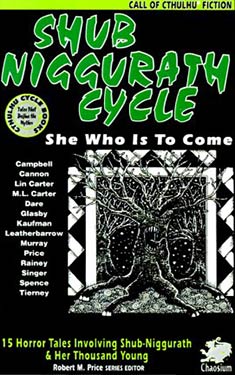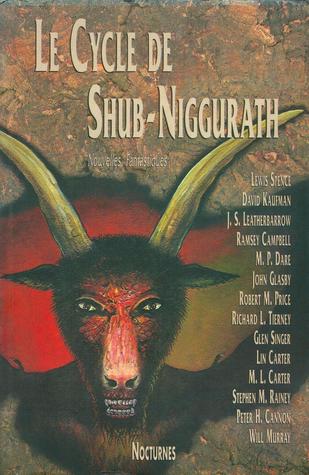…so from the wells of night to the gulfs of space, and from the gulfs of space to the wells of night, ever the praises of Great Cthulhu, of Tsathoggua, and of Him Who is not to be Named. Ever Their praises, and abundance to the Black Goat of the Woods. Iä! Shub-Niggurath! The Goat with a Thousand Young!
—H. P. Lovecraft, “The Whisperer in Darkness” (Weird Tales Aug 1931)
 Few of the entities of the Cthulhu Mythos created by Lovecraft & his correspondents in the 1930s were implicitly or explicitly female; of those the most enduring in the imagination of Mythos writers and fans is Shub-Niggurath. Mother Hydra, whatever her literary charms, has not inspired multiple anthologies dedicated to her. Shub-Niggurath is itself nebulous, never appearing on the scene, but as an element of ecstatic worship and invocation in several of Lovecraft’s stories; in “The Mound” Shub-Niggurath is portrayed as a “sophisticated Astarte,” in Clark Ashton Smith’s “The Holiness of Azédarac” the familiar epithet is given a masculine twist as “the Ram with a Thousand Ewes”; it is only in his letters Lovecraft described Shub-Niggurath explicitly:
Few of the entities of the Cthulhu Mythos created by Lovecraft & his correspondents in the 1930s were implicitly or explicitly female; of those the most enduring in the imagination of Mythos writers and fans is Shub-Niggurath. Mother Hydra, whatever her literary charms, has not inspired multiple anthologies dedicated to her. Shub-Niggurath is itself nebulous, never appearing on the scene, but as an element of ecstatic worship and invocation in several of Lovecraft’s stories; in “The Mound” Shub-Niggurath is portrayed as a “sophisticated Astarte,” in Clark Ashton Smith’s “The Holiness of Azédarac” the familiar epithet is given a masculine twist as “the Ram with a Thousand Ewes”; it is only in his letters Lovecraft described Shub-Niggurath explicitly:
Yog-Sothoth’s wife is the hellish cloud-like Shub-Niggurath, in whose honour nameless cults hold the rite of the Goat with a Thousand Young. By her he has two monstrous offspring—the evil twins Nug and Yeb. He has begotten hellish hybrids upon the females of various organic species throughout the universes of space-time (cf. “The Dunwich Horror”) [. . .]
—H. P. Lovecraft to Willis Conover, 1 Sep 1936, Selected Letters 5.303
Most of the stories about Shub-Niggurath that have been published are written by men. This may not be terrible surprising: most Cthulhu Mythos published has been written by men. When “Prey of the Goat” first appeared in The Shub-Niggurath Cycle (1994), M. L. Carter was the only woman whose work was represented among the offerings.
 The horrors of Lovecraft were, by and large, of equal terror to all—you don’t need to be a white male to appreciate cosmic horror, and assigning sex and gender to some of the more alien creatures of the Mythos may be a somewhat laughable enterprise—a diminution of these eldritch deities to prosaic human concerns. But there is a caveat: sex exists in Lovecraft’s fiction, and with the purpose: procreation. Female characters, be they willing participants or victims, may lay with and beget monsters. Important segments of Lovecraftian fiction fall into the familiar cycles of the “demon lover” or “rape fantasy,” which Margaret L. Carter recognized:
The horrors of Lovecraft were, by and large, of equal terror to all—you don’t need to be a white male to appreciate cosmic horror, and assigning sex and gender to some of the more alien creatures of the Mythos may be a somewhat laughable enterprise—a diminution of these eldritch deities to prosaic human concerns. But there is a caveat: sex exists in Lovecraft’s fiction, and with the purpose: procreation. Female characters, be they willing participants or victims, may lay with and beget monsters. Important segments of Lovecraftian fiction fall into the familiar cycles of the “demon lover” or “rape fantasy,” which Margaret L. Carter recognized:
H. P. Lovecraft, who was strongly influenced by Arthur Machen, has a wizard’s daughter raped by the outcast dark divinity, Yog-Sothoth, in “The Dunwich Horror.” The girl gives birth to twins, one a queerly repulsive boy who grows at an impossible rate but looks outwardly human, the other an invisible monstrosity, formed of elements alien to this universe. Asenath in “The Thing on the Doorstep” is the result of a union between a blasphemously evil necromancer and a “thing from the sea.”
—M. L. Carter, introduction to Demon Lovers and Other Strange Seductions (1972)
Carter brings this understanding and approach to the sexuality of the Cthulhu Mythos to “Prey of the Goat.” As a horror story, it hits familiar beats: a strange, horrible old artifact. Disturbing dreams. Carnal acts that hint at possession. Prayer and invocations. A victory…with an aftermath. The “demon’s” name is Shub-Niggurath, but the aesthetics are not beholden to Lovecraft; this is the erotic nightmare in a Christian Episcopal mold, a new priest facing an old Catholic terror without even a rite of exorcism in his arsenal. The Mythos elements are prominent, but reserved; Carter seeds a few connections without going overboard. This is a story that ties in to the larger Cthulhu Mythos, but its world is intimate, focused on just two people and their relationship.
The protagonist is Father Michael Emeric, the recipient of the amulet of Shub-Niggurath is his wife Terri. Much of the fine detail in the plot is not devoted to Mythos minutiae, but on the dynamics of the relationship between the two, their respective roles of husband and wife, man and woman; Michael tries not to overstep, to respect Terri’s agency, but when he does feel the need to undermine it finds it surprisingly easy. There’s an undercurrent in the story when it demonstrates how easy it is for Michael to slip into stereotypical masculinity to get what he wants, yet also how reluctant he is to do that. Terri for her part shares a distinct parallel with the female protagonist of Tina L. Jens’ “In His Daughters’ Darkling Womb (1997)”:
If they could have had a baby—but years of trying had produced no conception, with infertility tests failing to reveal the cause. Now that Terri was past thirty, they’d given up.
Infertility as a literary device has its uses: it it obviates the question of why characters do not have children, it makes conception (if it does happen) all the more miraculous or unholy. Yet there is a fundamental difference in approach between how Carter and Jens use it in these stories—in Jens’ story, the protagonist is female, the miscarriages she suffers are a result of failing to carry to term rather than failure to conceive; in Carter’s the protagonist is male, and the cause of the infertility is more ambiguous. If the infertility tests have failed to reveal a cause, is that because the cause lies not within her, but within her husband?
Carter essentially is putting the infertility fear on the other foot: not the feminine fear of miscarriage, or inability to have children, or birthing a monster, but the masculine fear of being cuckolded. The title “Prey of the Goat” forces the reader to ask the question: who is the prey, Michael or Terri? Certainly, the pastor’s wife is the one possessed by Shub-Niggurath, the one who has to suffer through the terrible erotic dreams where:
Then the goat stepped down into the crowd. She grabbed the first man and forced him to—forced him into her. He screamed.
But Terri tells her husband, when he asks her role in the dream, “I was the goat!” Later on, Michael wakes to find his possessed wife riding him—a rare example of rape of a man by a woman in Mythos fiction—the first dream is revealed as foreshadowing. Terri is the focus of the supernatural activity of the story, but the plot involves both of them, and this feeds into the ambiguous sexuality of Shub-Niggurath, who blends male and female characteristics in its appearance here. Whether Michael is threatened by the superior masculine aspect of Shub-Niggurath, or by the sexual dominance asserted by Terri under the Goat’s influence, the unexpected menage has Michael questioning his inadequacy, an attitude that carries right through to the foreboding end of the story. Abortion is ruled out by faith, but also by Michael’s impotent clutching at straws: “Besides, she might be wrong. It might be mine.”
“Prey of the Goat” almost never appeared at all; it was originally accepted for Lin Carter’s Weird Tales published by Zebra Books, but that series ended in 1983. If not for The Shub-Niggurath Cycle a decade later, it might never have seen publication at all. Which is a shame since it is a deceptively simple plot which is well worth deeper consideration. Carter has returned to the Mythos a few times, most notably with the romance novel Windwalker’s Mate (2008) and the erotic novella Tentacles of Love (2009).
Bobby Derie is the author of Sex and the Cthulhu Mythos (2014)